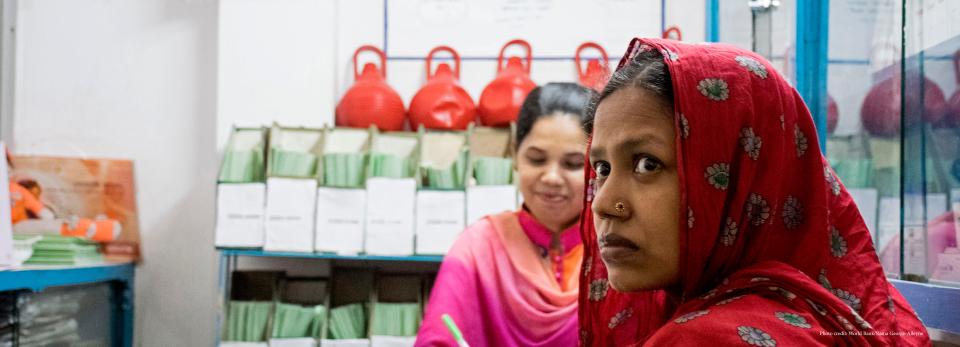Making Family Planning Count
Making Family Planning Count is an initiative of the Population Division to improve the quantity, quality, transparency and accessibility of family planning indicators and the population data that underlie models of the determinants and impacts of use of family planning. The goal is to improve the global community's ability to track progress in meeting the need for family planning and the accessibility and transparency of the underlying demographic data required for estimating family planning indicators. The work supports advocacy and accountability efforts to strengthen the political commitment to global health, including initiatives such as Family Planning 2020 and global monitoring of Target 3.7. to "ensure universal access to sexual and reproductive health-care services, including for family planning" under the 2030 Agenda for Sustainable Development. The project has been funded by the Bill & Melinda Gates Foundation Grants No. OPP1183453 (2018-2021) and OPP1110679 (2015-2017).
Data and tools
- E-Learning for SDG indicator 3.7.1 [PowerPoint] [Video]
- E-Learning for SDG indicator 3.7.2 [PowerPoint] [Video]
- Interactive Data Portal
- World Contraceptive Use
- Family Planning Indicators
- Women of Reproductive Age Who Are Married or in a Union 2024
- World Marriage 2019. Dataset
- Family Planning Estimation Tool (FPET)
- Global monitoring of SDG indicators
Selected Population Division publications
Highlights
- World Family Planning 2022
- World Family Planning 2020 Highlights
- World Fertility and Family Planning 2020 Highlights
- World Family Planning 2017 Highlights
Data booklet
- Contraceptive Use by Method 2019 Data Booklet
- Family Planning and the 2030 Agenda for Sustainable Development 2020 Data Booklet
Technical paper
- Molitoris, J., V. Kantorová and P. Gerland (2025). Assessing the impact of the loss of the Demographic and Health Surveys on global population and family planning data and estimates and on population research. United Nations, Department of Economics and Social Affairs, Population Division, Technical Paper No. UN DESA/POP/2025/TP/No.10.
- Methods for estimating and projecting key family planning indicators among all women of reproductive age. Technical Paper No. 2018/2
- Who collects what on the current use of contraception? Technical Paper No. 2017/12
- Sexual activity by marital status and age. Technical Paper No. 2017/11
Population factsheet
- Global progress in satisfying the need for family planning. Population Facts No. 2019/3
- Tracking global progress in family planning. Population Facts No. 2017/11
Selected journal articles
- Molitoris, J. and V. Kantorová (2025). World Contraceptive Use: A Global Compilation of Survey-Based Estimates on Contraceptive Use by Method, Age, and Marital Status. Studies in Family Planning, 1-11. https://doi.org/10.1111/sifp.70039.
- Bearak, J. M., and others (2025). Undesired Births, Contraception, and Abortion Before and After the Cairo Consensus: Trends in Conditional Undesired Birth Rates and the Impact of Contraception and Abortion. Studies in Family Planning, vol. 56, Issue 2, pp. 274-300. https://doi.org/10.1111/sifp.70014.
- Wheldon, M., and others (2024). A new look at contraceptive prevalence plateaus in sub-Saharan Africa: A probabilistic approach. Demographic Research, vol. 50, Issue 31, pp. 899–928. Available at https://doi.org/10.4054/DemRes.2024.50.31.
- Bearak, J. M., L. Alkema, V. Kantorová and J. Casterline (2023). Alignment between Desires and Outcomes among Women Wanting to Avoid Pregnancy: A Global Comparative Study of “Conditional” Unintended Pregnancy Rates. Studies in Family Planning, vol. 54, Issue 1, pp. 265-280. Available at https://doi.org/10.1111/sifp.12234.
- Biddlecom, A., and others (2023). Setting Health Targets Using Information from Probabilistic Projections: A Research Brief on an Application to Contraceptive Coverage. Population Research and Policy Review, vol. 42, Issue 13. Available at https://doi.org/10.1007/s11113-023-09766-2.
- Molitoris, J., and others (2023). Early Childbearing and Child Marriage: An Update. Studies in Family Planning, forthcoming. Available at https://doi.org/10.1111/sifp.12243.
- Dasgupta, Aisha, and others (2022). Contraceptive use and fertility transitions: The distinctive experience of sub-Saharan Africa. Demographic Research, vol. 46, Issue 4. Available at 10.4054/DemRes.2022.46.4
- Kantorová, V., and others (2021). Contraceptive use and needs among adolescent women aged 15–19: Regional and global estimates and projections from 1990 to 2030 from a Bayesian hierarchical modelling study. PLOS One, vol. 16, Issue 3. Available at doi.org/10.1371/journal.pone.0247479
- Dasgupta, A., V. Kantorová and P. Ueffing (2020). The impact of the COVID-19 crisis on meeting needs for family planning: a global scenario by contraceptive methods used. Gates Open Res, vol. 4, No. 102. Available at doi.org/10.12688/gatesopenres.13148.1.
- Kantorová, V., M. Wheldon, P. Ueffing and A. Dasgupta (2020). Estimating progress towards meeting women’s contraceptive needs in 185 countries: A Bayesian hierarchical modelling study. PLOS Medicine, vol. 17, Issue 2. Available at doi.org/10.1371/journal.pmed.1003026.
- Ueffing, P., A. Dasgupta and V. Kantorová (2019). Sexual activity by marital status and age: a comparative perspective. Journal of Biosocial Science, vol. 52, Issue 6, pp. 860-884. Available at doi.org/10.1017/S002193201900083X.
- Biddlecom, A., and others (2018). Future Scenarios of Adolescent Contraceptive Use, Cost and Impact in Developing Regions. New York: Guttmacher Institute, doi.org/10.1363/2018.29732.
- Kantorová, V., and others (2017). Setting Ambitious yet Achievable Targets Using Probabilistic Projections: Meeting Demand for Family Planning. Studies in Family Planning, vol. 48, No. 3, pp. 223-233. Available at doi.org/10.1111/sifp.12025.
- Alkema, L., and others (2013). National, regional, and global rates and trends in contraceptive prevalence and unmet need for family planning between 1990 and 2015: a systematic and comprehensive analysis. The Lancet, vol. 381, No. 9878, pp.1642-1652. Available at doi.org/10.1016/S0140-6736(12)62204-1.
Where are the project results used
These data compilations and estimates and projections of family planning and related indicators are used throughout the family planning sector. They are crucial for the ability of other organizations to disseminate data, advocate for improved access to family planning and used in research on the determinants and impacts of improved access to family planning. Users include international organizations, research institutes, academia, media, civil society and others. For example:


